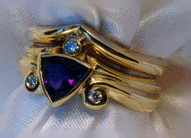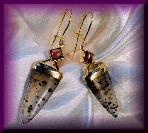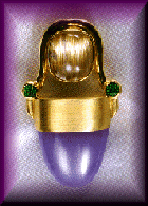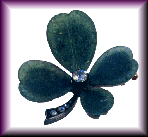
In a Quandary Over Quartz?By Judith Anderson GG, CGA |
| Quartz is the most common mineral on earth and is found in a greater number of varieties than any other mineral. It is little surprise that this versatile gem has been a favorite with jewelry makers and goldsmiths throughout the ages. Below is a guide to everything you ever wanted to know, but were afraid to ask, about quartz. |
|
Members of the crystalline quartz group include: amethyst, citrine, rock crystal, rutilated quartz, smoky quartz, rose quartz, aventurine quartz, tiger's eye and hawk's eye. In its purest state quartz is colorless. The colors often seen in quartz crystals is caused by impurities trapped in the gems molecular structure. This type of coloring is known as allochromatic.
Rock crystal is a pure, colorless variety of quartz and has several dubious nicknames; like, "Arkansas Diamond", "Herkimer Diamond", "Arizona Diamond" and "Cornish Diamond". All of these terms are misleading and probably relate to incidents where shifty characters attempted to pass off rock crystals as more valuable diamonds to unsuspecting investors. The name rock crystal is actually derived from the ancient Greek word "krystallos" which means clear ice. At one time it was believed that rock crystal was ice that had become so frozen it could no longer melt. Throughout the ages magicians and astrologers have used rock crystals as a gazing globes in which they can see the future and visit with apparitions beyond the veil. |
|
Amethyst is perhaps the best known and most admired variety of quartz. Its name is derived from the ancient Greek word "amethustos" which loosely translates to "impervious to alcohol". The ancient Greeks believed that the wearer of an amethyst jewel would be unaffected no matter how much wine they drank. Set in yellow gold amethyst also makes for a wonderful jewel.
The finest amethysts display a purple to purplish-red hue with flashes of violet and red. The finest examples are sometimes referred to as "Siberian amethysts", because the frozen wastes of eastern Russia were once the main source for these fine gemstones. |
|
Smoky quartz has a grayish-yellow to grayish-brown color which was probably caused by natural radiation emanating from surrounding rocks. This gem is often described as "Smoky Topaz" which is misleading since it is actually quartz and in no way related to topaz.
Rose quartz is a semi-transparent to translucent stone that displays various tones and intensities of pink. |
|
The cryptocrystalline varieties, also known as chalcedonies, include: agates, carnelians, sard, chrysoprase, chrysocolla, bloodstones, jasper, onyx and fire agates.
Agate was one of the earliest gemstones found in ancient jewels and artifacts. It was used as early as 3000 BC for ceremonial ax heads, bowls, cups, seals, and signet rings. Agates display a variety of colors arranged in curved bands with various degrees of translucency. Bloodstone, sometimes called heliotrope, is a dark green stone with reddish flecks. It was once believed to be an amulet that would stop bleeding. Several legends have existed to explain this gemstone's coloring. One attributes the red flecks to the blood of Christ. Another suggests that bloodstones are fallen bits of the sun and that they can be used to create thunder and lightning. The name jasper is a general term used to describe almost any semi translucent to opaque variety of quartz. They occur in a wide range of colors, usually without any patterns. Carnelian glows with a medium brownish-orange color. While sard is similar to carnelian in color, but much darker in tone. |
|
Chrysocolla is an intense light blue or blue-green color with semi transluscence. This beautiful gemstone is quite rare. On the other hand, chrysoprase is a yellowish-green color and is more common.
Last, but not least, fire agate is a brownish-red gem that displays a shimmering brilliance and iridescence similar to the play of colors seen in opals. The beauty of fire agate lies in its vivid display with the added benefits of greater hardness and durability than opal at a lower cost. |
|
|
||
|
| Reading Room | Jewelry Galleries | What's New! | | Bijoux Home Page | About Us | Services We Offer | Site Map | If you have any questions, suggestions or comments, please give us a call (603 624-8672) or send us an email.
|
||
|
© Copyright Bijoux Extraordinaire, Ltd. 1998 - 2000 All Rights Reserved |
||




